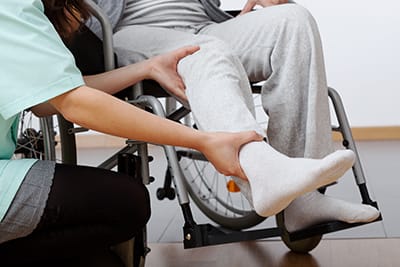When he decided to give snowboarding a try, 51-year-old Kris Bickell wasn't worried about the challenge. He was already a decent skier.
As predicted, it went great -- until he moved off the chairlift. "One foot got stuck in the snow, while the other kept sliding down the slope on the snowboard," Bickell says. The result: a torn labrum in both hips.
Bickell, who lives in Cheshire, CT, and is an online learning director at a local university, took his accident in stride. But the recovery has been slower than he figured. He's had more than 50 physical therapy sessions, countless at-home exercises -- and a whopping supply of support from his wife, Ann.
When you're a caregiver, it's important to keep things in perspective. Bouncing back from surgery or illness can take longer than you expect. Try to think of your loved one's rehab as a marathon, not a sprint.

Expect Ups and Downs
The person you're caring for may make huge strides one day and slide backward the next. That's normal. Don't worry if a sudden burst of recovery is followed by a standstill. It's fine as long as there's an overall upward slope.
"You're always looking for some progress," says Jay Neidich, vice president of rehabilitative services for VNA Healthtrends. If you don't see gradual improvement over time, talk to his doctor.
Set Realistic Goals
Base your expectations for his ability to move on how well he got around before his surgery or illness.
"The goal is to get the patient back to their prior level of function," Neidich says. "If they walked 50 feet with a rolling walker, that's the goal. If they were walking 500 feet -- that should be the goal."
In the beginning, he may need to use things like a cane, crutches, or a walker. Bickell remembers how important they were.
"I had two 80-year-old neighbors. One offered me her walker and the other, her cane," he says. "At first I said, 'No way,' then came to my senses. They both helped so much."
Expect progress to unfold in stages. During the first phase, for example, crutches may help your loved one feel comfortable as he builds up strength. Then he'll move to the next stage, which may be walking on his own.
Independence is a positive, realistic target to shoot for. The more he can do himself, the better.
Celebrate Small Victories
Even a tiny improvement is something to cheer about. In the beginning, it can be as simple as sitting up in bed. It's the first step toward getting around more freely.
"Once I was able to walk around the neighborhood," Bickell says, "I was ecstatic."
Each small step is a sign of progress. Celebrate each one in all its glory. Give your loved one a hug or a high-five when he passes some key milestones:
- Dresses himself for the first time
- Showers by himself
- Walks up steps
- Strolls outside
- Drives a car
Be Understanding
Keep in mind that recovery can take an emotional toll. Bickell recalls some tough days. "The mental part is hard, too," he says. "My wife helped tremendously. The biggest help was just having her there to listen."
Your loved one may be frustrated that he needs to rely on you to get around, especially if he's used to being independent. "That's very difficult for a lot of people to work through," Neidich says. Your support and patience can be a big help.
Help, but Not Too Much
As a caregiver, you may feel like you want to do as much as you can for your loved one. But that can backfire. If you do everything for him, he'll lose motivation to do things for himself.
The trick is to help without doing too much. For example, guide him out of bed, but don't physically lift him out. "Be there if you need to, but don't be so gung-ho to do it for him," Neidich says. In other words, help him help himself.
Reassure your loved one that recovery takes time and remind him how far he's come. When he says, "I wish I didn't need help just to walk to the end of the driveway," tell him, "But a week ago, you couldn't even walk out your front door."
This article is offered in partnership with WebMD. To view the original content, please visit WebMD.com.